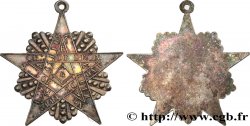fjt_1017946 - FRANC-MAÇONNERIE - PARIS BONAPARTE 1852
170.00 €
Cantidad
Añadir a su cesta

Tipo : BONAPARTE
Fecha: 1852
Metal: cobre dorado
Diámetro: 33 mm
Eje de acuñación: 12 h.
Peso: 11,52 g.
Canto: lisse
Cuño: sans poinçon
Comentarios sobre el estado de conservación:
Patine hétérogène avec des traces de rayures et points d’oxydation. Joli brillant de frappe encore visible
N° en los catálogos de referencia :
Anverso
Titulatura del anverso: (RECTANGLE REPRÉSENTANT UN PLAN SIMPLIFIÉ D’UNE LOGE) BONAPARTE / FONDEE EN 5852.
Descripción del anverso: Abeille.
Reverso
Titulatura del reverso: JETON DE PRESENCE ***.
Descripción del reverso: Equerre et compas entrecroisés et entrelacés avec une couronne d’acacia, autour d’un G.
Comentario
Loge de la famille impériale comptant 160 membres regroupant alors Jérôme Napoléon Bonaparte, Charles Bonaparte mais aussi les rois de Danemark et de Suède ainsi que des diplomates du monde entier. Marc Labouret nous indique que la loge repasse à 65 membres en 1862 et devient la loge de la France maçonnique. Puis s’éteindra en 1871. Marc Labouret précise à juste titre que sous la première phase du Second Empire, la Franc-maçonnerie est contrainte à la soumission, c’est la raison pour laquelle de nombreuses loges fermes. Dès 1860, les loges républicaines fleurissent à nouveau.
Lodge of the imperial family with 160 members, including Jérôme Napoléon Bonaparte, Charles Bonaparte, but also the kings of Denmark and Sweden, as well as diplomats from around the world. Marc Labouret tells us that the lodge returned to 65 members in 1862 and became the lodge of Masonic France. Then it died out in 1871. Marc Labouret rightly points out that during the first phase of the Second Empire, Freemasonry was forced into submission, which is why many lodges closed. From 1860, republican lodges flourished again.
Lodge of the imperial family with 160 members, including Jérôme Napoléon Bonaparte, Charles Bonaparte, but also the kings of Denmark and Sweden, as well as diplomats from around the world. Marc Labouret tells us that the lodge returned to 65 members in 1862 and became the lodge of Masonic France. Then it died out in 1871. Marc Labouret rightly points out that during the first phase of the Second Empire, Freemasonry was forced into submission, which is why many lodges closed. From 1860, republican lodges flourished again.








 Informar de un error
Informar de un error Imprimir la página
Imprimir la página Comparte mi selección
Comparte mi selección Haz una pregunta
Haz una pregunta Consignar / vender
Consignar / vender
 Descriptivo
Descriptivo












